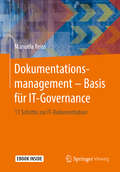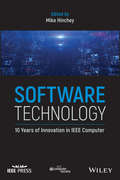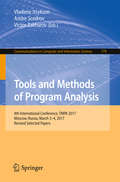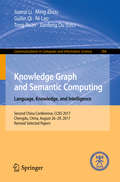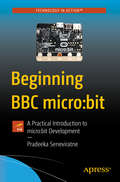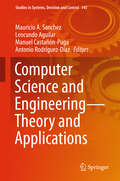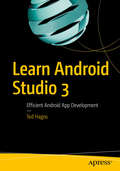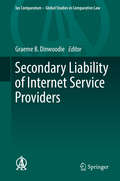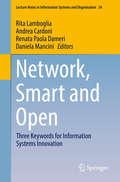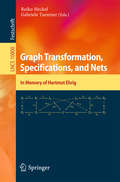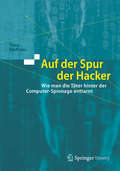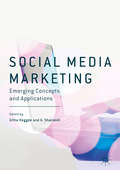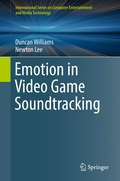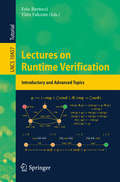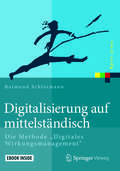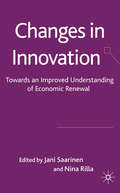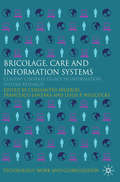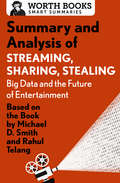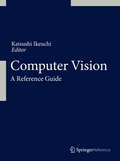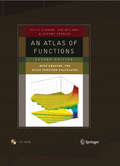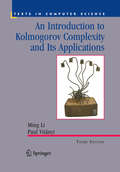- Table View
- List View
Dokumentationsmanagement – Basis für IT-Governance
by Manuela ReissIm Buch erfahren Sie nicht nur, warum IT-Dokumentation ein wichtiges Managementwerkzeug ist, sondern auch, wie Sie dieses Werkzeug Schritt für Schritt einrichten und pflegen. Im Fokus steht das von der Autorin entwickelte und in der Praxis erprobte Vorgehensmodell zum Aufbau einer ganzheitlichen und managementorientierten IT-Dokumentation zur Unterstützung von IT-Governance. Mit seinem Glossar leistet das Buch darüber hinaus einen Beitrag zur Standardisierung der Begriffe, die im Umfeld des Themas Dokumentation verwendet werden. Damit richtet sich das Buch an alle, die sich wissenschaftlich fundiert mit der praktischen Umsetzung der IT-Dokumentation auseinandersetzen möchten.
Software Technology: 10 Years of Innovation in IEEE Computer
by Mike HincheyA comprehensive collection of influential articles from one of IEEE Computer magazine’s most popular columns This book is a compendium of extended and revised publications that have appeared in the “Software Technologies” column of IEEE Computer magazine, which covers key topics in software engineering such as software development, software correctness and related techniques, cloud computing, self-managing software and self-aware systems. Emerging properties of software technology are also discussed in this book, which will help refine the developing framework for creating the next generation of software technologies and help readers predict future developments and challenges in the field. Software Technology provides guidance on the challenges of developing software today and points readers to where the best advances are being made. Filled with one insightful article after another, the book serves to inform the conversation about the next wave of software technology advances and applications. In addition, the book: Introduces the software landscape and challenges associated with emerging technologies Covers the life cycle of software products, including concepts, requirements, development, testing, verification, evolution, and security Contains rewritten and updated articles by leaders in the software industry Covers both theoretical and practical topics Informative and thought-provoking throughout, Software Technology is a valuable book for everyone in the software engineering community that will inspire as much as it will teach all who flip through its pages.
Tools and Methods of Program Analysis
by Vladimir Itsykson Andre Scedrov Victor ZakharovThis book constitutes the refereed proceedings of the 4th International Conference on Tools and Methods for Program Analysis, TMPA 2017, Moscow, Russia, March 3-4, 2017. The 12 revised full papers and 5 revised short papers presented together with three abstracts of keynote talks were carefully reviewed and selected from 51 submissions. The papers deal with topics such as software test automation, static program analysis, verification, dynamic methods of program analysis, testing and analysis of parallel and distributed systems, testing and analysis of high-load and high-availability systems, analysis and verification of hardware and software systems, methods of building quality software, tools for software analysis, testing and verification.
Knowledge Graph and Semantic Computing. Language, Knowledge, and Intelligence
by Ming Zhou Guilin Qi Juanzi Li Jianfeng Du Tong Ruan Ni LaoThis book constitutes the refereed proceedings of the Second China Conference on Knowledge Graph and Semantic Computing, CCKS 2017, held in Chengdu, China, in August 2017. The 11 revised full papers and 6 revised short papers presented were carefully reviewed and selected from 85 submissions. The papers cover wide research fields including the knowledge graph, the Semantic Web, linked data, NLP, knowledge representation, graph databases.
Beginning BBC micro:bit
by Pradeeka SeneviratneLearn essential concepts and techniques to build simple-to-advanced projects and overcome common programming challenges in micro:bit development. Beginning BBC micro:bit will take you through the complete features and capabilities of the micro:bit controller, enabling you to program and build your own projects. The uses are endless for the micro:bit and this books will help get you started on building your next project with this popular and easy-to-use microcontroller. You'll use online Python Editor and Mu Editor to build your own applications. Reviewed by the micro:bit developer team, this comprehensive guide also provides clean code examples to help you learn the key concepts behind the micro:bit API. What You’ll LearnWork with the various kits and accessoriesMaster the micro:bit development platform with easy to follow examples and clean codeBuild your own micro:bit applications using an online Python editor and Mu editorUse the on-board LED matrix, built-in buttons, I/O pins, accelerometer, and compassLearn how to connect and communicate with devices through I2C, SPI, and UARTBuild applications with music and speech librariesUse Local Persistent File System to store and manipulate filesBuild applications based on wired and radio networksUse micro:bit and micro:bit Blue appsWho This Book Is ForBeginners, those already experienced with electronics, and hobbyists at all levels looking to get started with a new microcontroller.
Computer Science and Engineering—Theory and Applications
by Mauricio A. Sanchez Leocundo Aguilar Manuel Castañón-Puga Antonio Rodríguez-DíazThis book presents a collection of research findings and proposals on computer science and computer engineering, introducing readers to essential concepts, theories, and applications. It also shares perspectives on how cutting-edge and established methodologies and techniques can be used to obtain new and interesting results. Each chapter focuses on a specific aspect of computer science or computer engineering, such as: software engineering, complex systems, computational intelligence, embedded systems, and systems engineering. As such, the book will bring students and professionals alike up to date on key advances in these areas.
Learn Android Studio 3
by Ted HagosBuild Android apps using the popular and efficient Android Studio 3 suite of tools, an integrated development environment (IDE) for Android developers using Java APIs. With this book, you’ll learn the latest and most productive tools in the Android tools ecosystem, ensuring quick Android app development and minimal effort on your part. Along the way, you’ll use Android Studio to develop Java-based Android apps, tier by tier through practical examples. These examples cover core Android topics such as notifications and toast; intents and broadcast receivers; and services. Then, you’ll learn how to publish your apps and sell them online and in the Google Play store. What You'll LearnUse Android Studio 3 to quickly and confidently build your first Android appsBuild an Android user interface using activities and layouts, event handling, images, menus and the action barIncorporate new elements including fragmentsIntegrate data with data persistence Access the cloud Who This Book Is ForThose who may be new to Android Studio 3 or Android Studio in general. You may or may not be new to Android development in general. Some prior experience with Java is also recommended.
Secondary Liability of Internet Service Providers
by Graeme B. DinwoodieThis book analyses the doctrinal structure and content of secondary liability rules that hold internet service providers liable for the conduct of others, including the safe harbours (or immunities) of which they may take advantage, and the range of remedies that can be secured against such providers. Many such claims involve intellectual property infringement, but the treatment extends beyond that field of law. Because there are few formal international standards which govern the question of secondary liability, comprehension of the international landscape requires treatment of a broad range of national approaches. This book thus canvasses numerous jurisdictions across several continents, but presents these comparative studies thematically to highlight evolving commonalities and trans-border commercial practices that exist despite the lack of hard international law. The analysis presented in this book allows exploration not only of contemporary debates about the appropriate policy levers through which to regulate intermediaries, but also about the conceptual character of secondary liability rules.
Network, Smart and Open
by Daniela Mancini Renata Paola Dameri Rita Lamboglia Andrea CardoniThis book presents a collection of original research papers addressing the relationship between information systems (IS) and innovation. “Open”, “Smart” and “Network” are three keywords that are currently guiding information systems (IS) innovation, enhancing IS potentialities and their ability to support decision-making processes. The book discusses the relevance of these three new concepts in connection with technological and organizational innovations (i.e. cloud, smart technologies and networking), and the role they play in the development of accounting and management information systems.The book’s primary aim is to investigate how these innovations could influence information systems (with a particular focus on accounting and management information systems) by enhancing their information potentialities and improving accounting methodologies, performance measurement systems, data management, information systems architectures, and external and internal reporting.The book is based on a selection of the best papers—original double-blind reviewed contributions—presented at the 2016 Annual Conference of the Italian Chapter of the Association for Information Systems (AIS).
Low Earth Orbit Satellite Design
by George Sebestyen Steve Fujikawa Nicholas Galassi Alex ChuchraIn recent decades, the number of satellites being built and launched into Earth’s orbit has grown immensely, alongside the field of space engineering itself. This book offers an in-depth guide to engineers and professionals seeking to understand the technologies behind Low Earth Orbit satellites.With access to special spreadsheets that provide the key equations and relationships needed for mastering spacecraft design, this book gives the growing crop of space engineers and professionals the tools and resources they need to prepare their own LEO satellite designs, which is especially useful for designers of small satellites such as those launched by universities. Each chapter breaks down the various mathematics and principles underlying current spacecraft software and hardware designs.
Graph Transformation, Specifications, and Nets
by Reiko Heckel Gabriele TaentzerThis volume pays tribute to the scientific achievements of Hartmut Ehrig, who passed away in March 2016.The contributions represent a selection from a symposium, held in October 2016 at TU Berlin, commemorating Hartmut’ s life and work as well as other invited papers in the areas he was active in. These areas include Graph Transformation, Model Transformation, Concurrency Theory, in particular Petri Nets, Algebraic Specification, and Category Theory in Computer Science.
Auf der Spur der Hacker
by Timo SteffensProfessionelle Hackerangriffe (sogenannte Advanced Persistent Threats) treffen heutzutage Regierungen, Unternehmen und sogar kritische Infrastrukturen wie Flughäfen oder Stromnetzbetreiber. Herauszufinden, welche Täter und Auftraggeber dahinter stecken, wird zunehmend wichtiger. Wenn man die Ursprünge eines Angriffs und seine Motive kennt, kann man sich besser schützen und die Konsequenzen eines Datendiebstahls effektiver begrenzen.Damit die Frage, ob ein Angriff aus Russland, China, einem anderen Land, oder von gewöhnlichen Kriminellen durchgeführt wurde, nicht eine Frage des Glaubens oder Bauchgefühls bleibt, soll dieses Buch einen Blick hinter die Kulissen der Ermittler und Analysten werfen. Ausführlich erläutert der Autor die IT-technischen Methoden, mit denen man den Tätern auf die Spur kommt, aber auch, wo diese Methoden an Grenzen stoßen. Zahlreiche Beispiele von aufwändigen Angriffen der letzten Jahre zeigen, wie die Täter falsche Fährten legen, oft genug aber auch Fehler machen, die sie überführen.So bietet der Autor, der seit mehreren Jahren gezielte Hackerangriffe von Spionagegruppen auf Behörden und Unternehmen untersucht, einen spannenden Blick hinter die Kulissen der Ermittler und Analysten. Neben Sicherheitsexperten staatlicher Behörden, Unternehmen, Stiftungen und NGOs, die regelmäßig zum Ziel von Cyberkriminalität werden, finden auch technische Journalisten und interessierte Laien in diesem Buch eine Fülle an Hintergrundwissen zur IT-Forensik.
EU-Datenschutz-Grundverordnung (DSGVO)
by Paul Voigt Axel von dem BusscheDieses Praktikerhandbuch enthält Hinweise zur praktischen Umsetzung der EU-Datenschutz-Grundverordnung (DSGVO) sowie eine systematische Analyse der neuen Vorschriften. Das Handbuch widmet sich unter anderem den organisatorischen und materiellen Datenschutzanforderungen, den Rechten der betroffenen Personen, der Rolle der Aufsichtsbehörden, der Rechtsdurchsetzung und den Bußgeldern nach der Verordnung, sowie nationalen Besonderheiten. Das deutsche Datenschutz-Anpassungs- und Umsetzungsgesetz EU (DSAnpUG-EU) wurde bereits umfassend berücksichtigt. Zusätzlich gewährt das Handbuch einen kompakten Überblick zu den Konsequenzen der Neuregelung für ausgewählte Verarbeitungssituationen mit hoher Praxisrelevanz, wie Cloud Computing, Big Data und Internet of Things. Die im Jahr 2016 verabschiedete DSGVO tritt im Mai 2018 in Kraft. Sie sieht zahlreiche neue bzw. verstärkte Datenschutzpflichten sowie eine deutliche Erhöhung der Bußgelder (auf bis zu 20 Mio. Euro) vor. Nicht nur in der Europäischen Union ansässige Unternehmen werden daher ihre Datenschutz-Compliance auf den Prüfstand stellen müssen; aufgrund des weiten, grenzüberschreitenden Anwendungsbereichs der Verordnung wird ihr Inkrafttreten Auswirkungen auf zahlreiche Unternehmen weltweit haben.
Social Media Marketing
by Githa Heggde G. ShaineshThis book focuses on the role of social media as the next major game-changer. Social media has emerged as the defining trend in the last decade and continues to restructure communication and interactions between individuals, communities, governments and businesses. Researchers and marketers are still struggling with the profound impact of rapidly evolving social media on viral user-generated content, its ability to shape consumer perceptions, and the constantly changing landscape for developing business cases to proactively engage with stakeholders. The growing opportunities to “hear” about customer priorities and concerns on company managed channels as well as third-party review sites, including social media pages, across the digital space are accompanied by the challenges of responding to these conversations in real-time, which calls for a massive shift in the way marketing functions engage in dialogue with customers. As leading users of social media in emerging markets, Indians are increasingly logging into their Facebook and Twitter accounts, with the country recording the highest growth in social networking. This book begins by discussing the impact of social media on marketing, from brand building, communications, and advertising to customization and customer engagement. The book approaches the subject matter systematically, identifying broad trends, concepts and frameworks in the first few chapters. It then goes on to address the varied application of social media in marketing for different sectors. Primarily focusing on understanding digital consumers, the book integrates social media with marketing and the outcome. It also presents new, selected cases of successful digital companies in emerging markets never before considered. Researchers and managers alike will find this book to be a handy reference guide to social media in emerging markets.
Emotion in Video Game Soundtracking
by Newton Lee Duncan WilliamsThis book presents an overview of the emerging field of emotion in videogame soundtracking. The emotional impact of music has been well-documented, particularly when used to enhance the impact of a multimodal experience, such as combining images with audio as found in the videogames industry. Soundtracking videogames presents a unique challenge compared to traditional composition (for example film music) in that the narrative of gameplay is non-linear – Player dependent actions can change the narrative and thus the emotional characteristics required in the soundtrack. Historical approaches to emotion measurement, and the musical feature mapping and music selection that might be used in video game soundtracking are outlined, before a series of cutting edge examples are given. These examples include algorithmic composition techniques, automated emotion matching from biosensors, motion capture techniques, emotionally-targeted speech synthesis and signal processing, and automated repurposing of existing music (for example from a players own library). The book concludes with some possibilities for the future.
Lectures on Runtime Verification
by Ezio Bartocci Yliès FalconeThe idea of this volume originated from the need to have a book for students to support their training with several tutorials on different aspects of RV. The volume has been organized into seven chapters and the topics covered include an introduction on runtime verification, dynamic analysis of concurrency errors, monitoring events that carry data, runtime error reaction and prevention, monitoring of cyber-physical systems, runtime verification for decentralized and distributed systems and an industrial application of runtime verification techniques in financial transaction systems.
Digitalisierung auf mittelständisch
by Raimund SchlotmannRaimund Schlotmann beschreibt in seinem Buch, wie man als technisches mittelständisches Unternehmen die neuen Möglichkeiten der Digitalisierung entzaubert und konkret anpackt. Das Buch nimmt dem Thema das Bedrohliche, Unkonkrete und macht anhand der verständlichen Methode "Digitales Wirkungsmanagement“ quasi als Bedienungsanleitung klar, was genau zu tun ist und wie der Mittelstand diese Veränderungen aktiv gestalten und als Chance für sich nutzen kann.„Digitalisierung auf mittelständisch“ rüttelt wach und stellt dar, wie sich durch die Verschiebung der Produktdifferenzierung von Hardware/Mechanik zu Software die Regeln ändern und sich Einfallstore für neue Wettbewerber öffnen. Das Buch erklärt mit welcher Denk- und Herangehensweise man sich der neuen Welt der Digitalisierung nähern kann.Agieren statt Reagieren, dazu soll das Buch anregen und richtet sich mit dieser Botschaft an alle, die im mittelständischen technischen Umfeld den Chancen, aber auch der Herausforderung durch Digitalisierung und Industrie 4.0 gegenüberstehen.
Biofuels: Greenhouse Gas Mitigation and Global Warming
by Ashwani Kumar Shinjiro Ogita Yuan-Yeu YauThis timely book is a compilation of edited articles by distinguished international scientists discussing global warming, its causes as well as present and future solutions. Social and economic growth at global level is measured in terms of GDP, which requires energy inputs generally based on fossil fuel resources. These, however, are major contributors to increasing levels of CO2, causing 15 tonnes of green house gas emissions per capita. Renewable sources of energy offer an alternative to fossil fuels, and would help reduce this to the 2 tonnes of greenhouse gas emissions per capita per annum needed to achieve sustainable growth. As such, the book discusses the next-generation of biofuels and all related aspects, based on the editors’ significant investigations on biofuels over the last 30 years. It also presents the latest research findings from research work carried out by contemporary researchers. Presenting global biofuel perspectives, it examines various issues related to sustainable development of biofuels in the contexts of agriculture, forestry, industry and economic growth. It covers the 1st to 4th generation biofuels, as well as the status of biofuel resources and their potential in carbon neutral economy. Offering a comprehensive, state-of-art overview of current and future biofuels at local and global levels, this book appeals to administrators, policy makers, universities and research institutions.
Changes in Innovation: Towards an Improved Understanding of Economic Renewal
by Jani Saarinen Nina RillaThis book is a collection of articles all contributing to the theme of changes in innovation and innovation processes, and aims to create new knowledge about crucial issues in the Finnish and global innovation environment which forms critical intelligence in innovation strategies for firms and decision makers.
Bricolage, Care and Information: Claudio Ciborra's Legacy in Information Systems Research (Technology, Work and Globalization)
by Giovan Francesco Lanzara Leslie P. Willcocks Chrisanthi AvgerouClaudio Ciborra was one of the most innovative thinkers in the field of information systems. This book explains the intellectual contribution of Ciborra's work in a substantial introductory chapter, contains the most significant of his articles, and provides a sample of research that draws from his ideas.
China’s Highway of Information and Communication Technology
by Jiang Yu Richard Li-HuaBased on first-hand information obtained from Chinese and Foreign enterprises and institutions in the Chinese ICT industry, this book presents a comprehensive analysis of the evolution of Chinese ICT industrial sector. It especially analyzes the strengths, weaknesses, and threats facing both the Chinese enterprise and western multinationals.
Summary and Analysis of Streaming, Sharing, Stealing: Big Data and the Future of Entertainment
by Worth BooksSo much to read, so little time? This brief overview of Streaming, Sharing, Stealing tells you what you need to know—before or after you read Michael D. Smith’s and Rahul Telang’s book. Crafted and edited with care, Worth Books set the standard for quality and give you the tools you need to be a well-informed reader. This short summary and analysis of Michael D. Smith and Rahul Telang’s Streaming, Sharing, Stealing includes: Historical context, Chapter-by-chapter summaries, Character profiles, Important quotes, Fascinating trivia, Glossary of terms, Supporting material to enhance your understanding of the original work. About Streaming, Sharing, Stealing by Michael D. Smith and Rahul Telang: There is a new world order in the entertainment industry. Digital technology has contributed to an explosion of content in the entertainment business as Netflix, Amazon, and Apple upend traditional entertainment, changing the way in which television, film, music, and books are made and consumed. In Streaming, Sharing, Stealing: Big Data and the Future of Entertainment, authors Smith and Telang document this massive change and demonstrate conclusively that making data-driven decisions and understanding customer behavior are the keys to the new marketplace. The summary and analysis in this ebook are intended to complement your reading experience and bring you closer to a great work of nonfiction.
Computer Vision: A Reference Guide
by Katsushi IkeuchiThis comprehensive reference provides easy access to relevant information on all aspects of Computer Vision. An A-Z format of over 240 entries offers a diverse range of topics for those seeking entry into any aspect within the broad field of Computer Vision. Over 200 Authors from both industry and academia contributed to this volume. Each entry includes synonyms, a definition and discussion of the topic, and a robust bibliography. Extensive cross-references to other entries support efficient, user-friendly searches for immediate access to relevant information Entries were peer-reviewed by a distinguished international advisory board, both scientifically and geographically diverse, ensuring balanced coverage. Over 3700 bibliographic references for further reading enable deeper exploration into any of the topics covered. The content of Computer Vision: A Reference Guide is expository and tutorial, making the book a practical resource for students who are considering entering the field, as well as professionals in other fields who need to access this vital information but may not have the time to work their way through an entire text on their topic of interest.
An Atlas of Functions: with Equator, the Atlas Function Calculator
by Keith B. Oldham Jerome Spanier Jan MylandThis second edition of An Atlas of Functions, with Equator, the Atlas Function Calculator, provides comprehensive information on several hundred functions or function families, of interest to all those scientists, engineers and mathematicians who are concerned with the quantitative aspects of their field. Beginning with simple integer-valued functions, the book progresses to polynomials, exponential, trigonometric, Bessel, and hypergeometric functions, as well as many more. The 65 chapters are arranged roughly in order of increasing complexity, mathematical sophistication being kept to a minimum while utility is stressed throughout. In addition to providing definitions and simple properties for every function, each chapter catalogs more complex interrelationships as well as the derivatives, integrals, Laplace transforms and other characteristics of the function. Numerous color figures in 2 or 3 dimensions depict their shape and qualitative features and flesh out the reader's familiarity with the functions. In many instances, the chapter concludes with a concise exposition on a topic in applied mathematics associated with the particular function or function family. Features that make the Atlas an invaluable reference tool, yet simple to use, include: full coverage of those functions--elementary and "special"--that meet everyday needsa standardized chapter format, making it easy to locate needed information on such aspects as: nomenclature, general behavior, definitions, intrarelationships, expansions, approximations, limits, and response to operations of the calculusextensive cross-referencing and comprehensive indexing, with useful appendicesthe inclusion of innovative software--Equator, the Atlas Function Calculatorthe inclusion of new material dealing with interesting applications of many of the function families, building upon the favorable responses to similar material in the first edition.
An Introduction to Kolmogorov Complexity and Its Applications (Texts in Computer Science)
by Ming Li Paul M. B. Vitányi"The book is outstanding and admirable in many respects. ... is necessary reading for all kinds of readers from undergraduate students to top authorities in the field." Journal of Symbolic Logic Written by two experts in the field, this is the only comprehensive and unified treatment of the central ideas and applications of Kolmogorov complexity. The book presents a thorough treatment of the subject with a wide range of illustrative applications. Such applications include the randomness of finite objects or infinite sequences, Martin-Loef tests for randomness, information theory, computational learning theory, the complexity of algorithms, and the thermodynamics of computing. It will be ideal for advanced undergraduate students, graduate students, and researchers in computer science, mathematics, cognitive sciences, philosophy, artificial intelligence, statistics, and physics. The book is self-contained in that it contains the basic requirements from mathematics and computer science. Included are also numerous problem sets, comments, source references, and hints to solutions of problems. New topics in this edition include Omega numbers, Kolmogorov-Loveland randomness, universal learning, communication complexity, Kolmogorov's random graphs, time-limited universal distribution, Shannon information and others.
